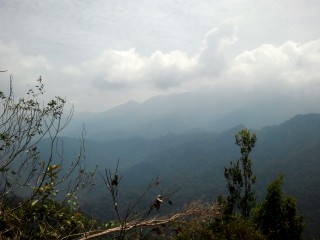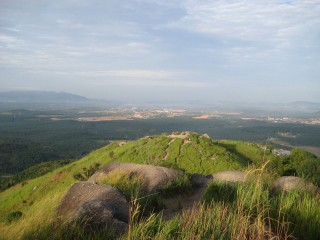DISCLAIMER: This post was written in 2012. Information may be out of date!
Location: Gohtong Jaya (Genting Highlands), Pahang, Malaysia.
Start point: 3.395699N, 101.767510E 922m a.s.l.
Summit: 3.374284N, 101.740044E 1441m a.s.l.
Difficulty: Moderately Hard. Some steep sections, trail is mostly muddy with a lot of obstacles. Not recommended as a first hike, but doable for anyone who exercises regularly.
Date climbed: Sat 1 Sep 2012
Having not climbed any challenging mountains for 2 weeks (not counting my 4th trip to Broga which I found to be easy & relaxed), I was itching to climb something new. I decided on Gunung Bunga Buah as it is fairly close to PJ/KL, and doesn’t have a reputation of being too difficult. I was a bit apprehensive as I was bringing along 3 other people (a total of 4 climbers) to a new location, and I had not climbed with any of them before. Further more, most of them had not done half/full day climbs before.
I would like to quickly touch on the subject of group dynamics, which should be an important aspect to consider – if you climb with people you’ve climbed with before, you know each other’s level of fitness & pacing, and how to motivate one another. I have to admit that I (as the navigator and person who researched the mountain) probably didn’t lead the group as well as I could have, and was too eager to plod on ahead at times. However, I’m glad that we all reached the summit safely and got back out before sunset.
Gunung Bunga Buah stands high at 1430m, but is different from other mountains like Nuang in that you start at relatively high altitude. The trail consists of many ups and downs rather than a single ascent to the summit and back. The great thing about this is that the whole climb is done in nice cool weather. On the other hand, do keep in mind that the return time from the summit will likely take the same amount of time. (On single ascent/descent mountains, the descent is almost always significantly faster) From the research I’ve done, Gunung Bunga Buah is also well known for its leeches. While I’m sure they do come out in large numbers after a rain, we only saw a few around on this particular day, and none of us got any bites. Needless to say, go mentally prepared for these bloodsuckers!
We left PJ around 7.20am, reaching Gohtong Jaya at 8.30am. It’s up to you how close you want to park to the starting point, which is a small orchard/farm. I decided to park in front of a restaurant at the shoplots, just for extra peace of mind as there is a lot more activity going on there. (Hopefully less chance of anything happening to the car, although these days anything can happen)
You’ll have to find your way through the orchard to the start of the trail. It’s a bit hard to describe, so either (1) use the GPS trail I recorded, (2) ask the people at the orchard, who were very friendly, or (3) if you have neither GPS nor people to ask, you’ll have to make a turn around one of the buildings and head towards the slope. Whatever you do, please watch your step and do not step on any of the plants at the orchard, as the land is private properly and we are outsiders ‘trespassing’ on their land to get to the trail. As goes without saying, do not litter – that goes for the whole journey!
The first part of the climb consists of a ~20 minute climb through steep and potentially slippery slopes. If you’re not used to these type of slopes, don’t despair, since it’s only for a short section. You’ll soon find yourself on an old tar road (which used to be the old road to Genting). Keep a mental image of this junction, as you’ll have to go back down the same way when coming back.

From here, keep walking along the road until you notice it bending sharply to the right. At this point, turn left into the undergrowth, and in a minute you’ll emerge at the well known old quarry, with it’s grand looking cliff. Honestly, the photos don’t do it justice – it’s a sight you have to see for yourself.


Keep walking along the road, which has been closed for such a long time that nature has already reclaimed most of it. Most of the time, you’ll be walking through dense undergrowth, and you’ll be “in touch” (literally!) with nature. As such, long pants are recommended (though not required), if not you may end up getting quite a few scratches and possibly rashes along the way.
At some point, you’ll find yourself on the other side of the mountain ridge, and you’ll get your first view of Bunga Buah’s peak. It may look far away, but it’s doable! The viewing point also includes a great view of the valley. On our climb, we could hear the loud cries of what we assume to be gibbons – though we never saw any of them.

Keep walking along the dense path (It’s hard to imagine cars drove here many years ago) until you reach the “real” trailhead which leads to Gunung Bunga Buah.

From here, there’s a short steep climb, followed by a long downhill section. It can be tiring going down, because you know that you’ll have to go up on the journey back! Interestingly, I tend to prefer going uphill as it’s always easier to find footing and easier on the joints. Those who have climbed Gunung Nuang will recognize the similar clay. Eventually, you’ll reach the bottom of this section, and begin the climb up towards the summit of Bunga Buah. While there are no extremely steep sections, what makes the trail difficult is the sheer number of objects lying across the path – branches, roots, rocks, etc., which you’ll have to either clamber over or crawl underneath. Some people say that Bunga Buah is tougher than Nuang – which may be due to the trail difficulty. (However, Nuang requires vastly more endurance and strength. Overall, I’d say that Nuang is still MUCH more difficult).
Along the way, you’ll come across a clearing with the word “AIR”. I assume that if you turn off at this junction, it would lead to a water source. We did not follow it this round.

About half and hour on, you’ll reach the start of the “Rock Garden”, which some say shares similarities to Bukit Tabur. It’s no where nearly as dangerous as Bukit Tabur, but provides a nice change in terrain. At this point, you’ll also be able to get the best view of Genting Highlands (if there are no clouds). We stopped here to eat our lunch. The ground around the rock garden is also oddly spongy. I’d strongly recommend you take careful steps – I don’t know how much weight the ground can take, or if it’s secure. The last thing you want to do is go tumbling down!

The summit of Gunung Bunga Buah lies about 30-40minutes from the rock garden. There’s a large clearing you’ll reach, but this is not the true summit. Just walk about half a minute further on until you see the triangular metal structure, and here you can end your journey! (I understand that the trail continues further on, down towards Batang Kali/Jalan Sungai Tua, which is a LONG way away)

As of September 2012, the summit is infested with bees, so if you don’t like bees, you probably won’t want to stay at the summit too long! On my climb, we set the turnaround time at 1.30pm, which gave us ample time to get back to Gohtong Jaya. Always set a turnaround time and stick to it strictly!
All in all, Gunung Bunga Buah was an enjoyable, relaxed climb. I’m not sure I’d care to return to it anytime soon, but it’s not bad. We ran into about 20 people in total along our climb, including a big group who had camped up at the summit the previous night. I expect that not many people (if any) climb Gunung Bunga Buah on weekdays. As with any climb, let someone know your plans. There is hardly any phone reception (Maxis, at least) throughout the climb (except near the start and towards the summit).
I have to congratulate 2 within my group – PY and ZR, who completed the climb with broken shoes. ALWAYS be sure to wear proper footwear when climbing places such as these!
GPS Details (From start to summit)
Duration: 4 hours 24 minutes (can be done much faster)
Length: 7km
Average Speed: 1.6km/h
Max elevation: 1441m
Min elevation: 922m
Vertical Up: 827m
Vertical Down: 310m
Download GPX, KMZ (Google Earth)
View on EveryTrail
Preparations
Average time: 4hrs up, 3.5hrs down. Plan accordingly. We started ~9am and set turnaround time at 1.30pm
- It’s not a race. Stick together, and if any can’t make it, turn back together.
- Depending on weather, may be cold.
- Bunga Buah is very famous for leeches. Dress appropriately or bring insect repellent if you want to avoid bites.
- Lots of shrubs/bushes, long pants recommended.
- Trail can be slippery.
Checklist:
- Minimum 2 liters drink, isotonic recommended
- High energy snacks/lunch
- Hiking shoes & extra socks for comfort, if you need
- Raincoat/poncho
- Small towel
- Hiking stick
- Insect Repellent
- Extra clothes (both shirt & pants), can leave in car
- Plastic bags for dirty shoes/clothes, can leave in car
- Extra slippers to change into afterwards, can leave in car
- Emergency gear: flashlight, whistle, knife, lighter, 1st aid kit
- Optional: gloves, tarp/flysheet, cord/string, mat, water filter/tablets, etc.
(See my personal packing list here)











